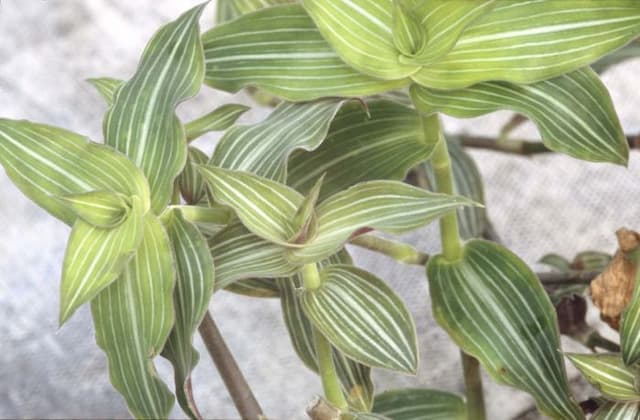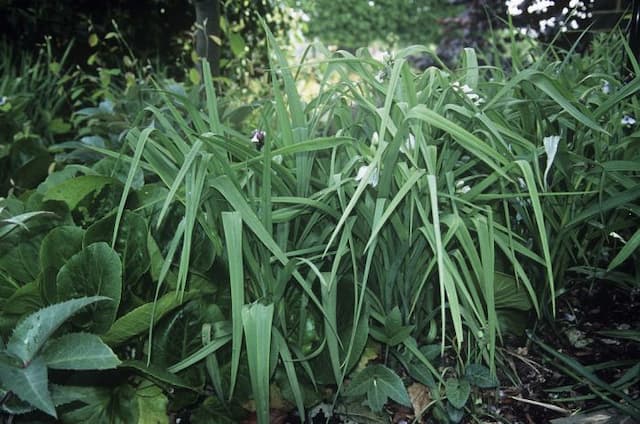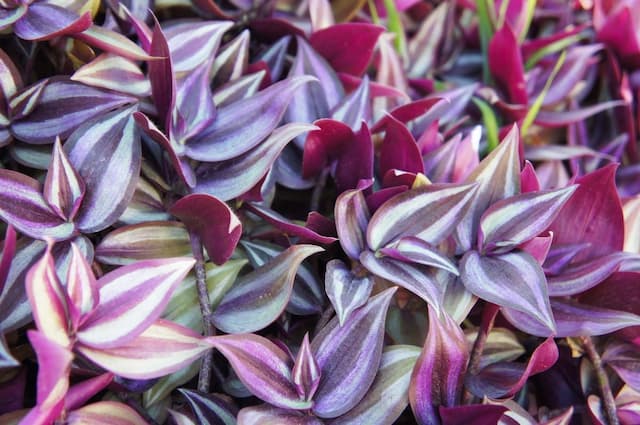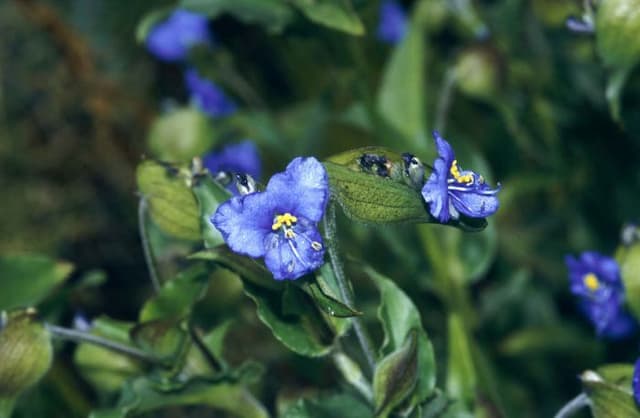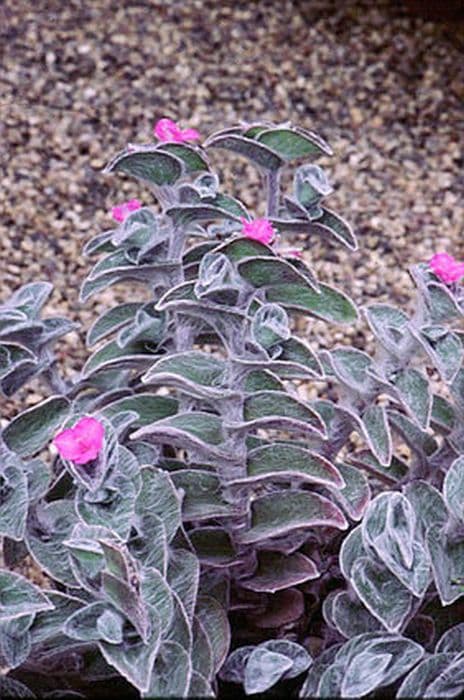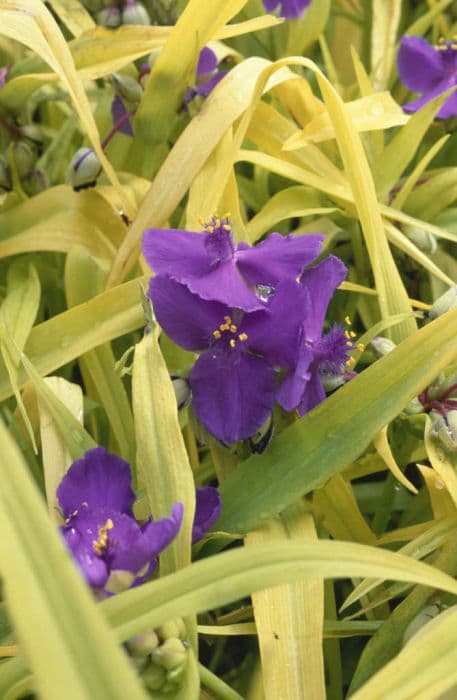Oyster Plant Tradescantia spathacea 'Vittata'
ABOUT
The Tradescantia spathacea 'Vittata', often referred to as Moses-in-the-cradle, is a striking ornamental plant known for its distinctive foliage. The leaves of Moses-in-the-cradle are lance-shaped with pointed tips and grow in a rosette pattern, creating a dense and tidy cluster. Each leaf showcases a stunning variegation pattern with creamy white and green stripes running longitudinally along its length. This variegation gives the plant a textured and vibrant appearance that is particularly eye-catching. The undersides of the leaves contrast sharply with the top, being a rich purple or magenta color, adding to the plant's visual appeal. The edges of the leaves are smooth, and the surface has a waxy sheen. True to its name, Moses-in-the-cradle produces small white flowers that are nestled within boat-shaped bracts, which are modified leaves. These bracts are typically a purple or pinkish color, creating a beautiful complement to both the striped foliage and the white blossoms. The bracts and flowers together form an interesting display, adding to the ornamental value of the plant. The contrast between the variegated leaves and the deep-toned undersides and bracts makes Moses-in-the-cradle a popular choice for both indoor and outdoor decoration, given its vibrant and colorful look without reference to its size.
About this plant
 Names
NamesFamily
Commelinaceae.
Synonyms
Moses-in-the-Cradle, Boat Lily, Oyster Plant.
Common names
Rhoeo spathacea 'Vittata', Rhoeo discolor 'Vittata', Rhoeo spathacea var. variegata, Ephemerum bicolor, Tradescantia discolor 'Vittata', Tradescantia versicolor 'Vittata'.
 Toxicity
ToxicityTo humans
The Tradescantia spathacea 'Vittata', commonly known as Moses-in-the-Cradle, may cause skin irritation due to its sap containing irritating chemicals. If accidentally ingested, the plant can cause pain and inflammation in the mouth and throat, nausea, vomiting, and diarrhea. It is advised to handle this plant with care and to keep it out of reach of children, who might be tempted to ingest it.
To pets
Moses-in-the-Cradle is toxic to pets, including cats and dogs. If a pet ingests any part of the plant, it could experience symptoms such as vomiting, drooling, irritation of the mouth, and difficulty swallowing. Owners should be cautious and prevent their pets from accessing or chewing on this plant to avoid possible poisoning.
 Characteristics
CharacteristicsLife cycle
Perennials
Foliage type
Evergreen
Color of leaves
Variegated
Flower color
White
Height
1-2 feet (0.3-0.6 meters)
Spread
1 foot (0.3 meters)
Plant type
Herb
Hardiness zones
9-11
Native area
Central America
Benefits
 General Benefits
General Benefits- Easy to Care For: The plant is low maintenance and can thrive in a range of indoor conditions, making it suitable for novice gardeners.
- Versatile in Design: Its striking green and white striped leaves make it a perfect ornamental addition to various interior designs.
- Fast Growing: Tradescantia spathacea 'Vittata' grows quickly, providing rapid satisfaction for gardeners and a swift green cover wherever needed.
- Tolerant to Drought: The plant is quite resilient to dry spells, requiring less frequent watering than many other houseplants.
- Pet Friendly: Unlike some houseplants, Tradescantia spathacea 'Vittata' is not toxic to pets, making it a safe choice for households with animals.
- Promotes Humidity: Like other houseplants, it increases humidity levels within its immediate vicinity, potentially improving respiratory health.
- Suitable for Terrariums: Due to its size and environmental requirements, it makes an excellent choice for both large and small terrariums.
- Easy Propagation: The plant can be easily propagated from stem cuttings, allowing for multiple new plants to be grown from an established mother plant.
- Compact Growth: Its compact size makes it ideal for smaller living spaces and for places like offices or apartments.
- Mood Enhancer: The vibrant foliage can help brighten a room and has been associated with boosting mood and creating a calming environment.
 Medical Properties
Medical Properties- This plant is not used for medical purposes.
 Air-purifying Qualities
Air-purifying QualitiesThis plant is not specifically known for air purifying qualities.
 Other Uses
Other Uses- Oyster Plant art - Tradescantia spathacea 'Vittata' can be used to create botanical art, as their striking striped leaves can add texture and a tropical feel to compositions.
- Jewelry elements - The leaves and cut stems can be incorporated into eco-friendly jewelry designs, either by encasing them in resin or by using them as templates for metalwork.
- Color inspiration - The variegated foliage can provide color palette inspiration for interior designers and artists looking for unique combinations of green and white.
- Photography subject - Due to their attractive striped patterns, Oyster Plants are often used by photographers as a subject for macro photography and plant portraiture.
- Education - They could serve as a model organism in educational settings for teaching about variegation in plants and how it can affect photosynthesis.
- Religious offerings - In some cultures, striking and unique plants like the Oyster Plant might be used in religious offerings or as part of ritual decorations.
- Plant-based inks - The pigments from the leaves may be used in the creation of natural inks for eco-conscious art projects and crafts.
- Fabric patterns - The unique patterns of the Oyster Plant's leaves can inspire patterns for textiles, wall coverings, and other fabric-based items.
- Wedding decor - Their distinctive appearance can make them a candidate for table centerpieces or decorative elements in eco-friendly or tropical-themed weddings.
- Biodegradable dishware - When dried, the sturdy leaves could potentially be used as a material for crafting biodegradable dishes or utensils for one-time use.
Interesting Facts
 Feng Shui
Feng ShuiThe Moses-in-the-Cradle is not used in Feng Shui practice.
 Zodiac Sign Compitability
Zodiac Sign CompitabilityThe Moses-in-the-Cradle is not used in astrology practice.
 Plant Symbolism
Plant Symbolism- Resilience: Tradescantia spathacea 'Vittata', also known as the Moses-in-the-Cradle, can tolerate varying lighting conditions and some neglect, symbolizing the ability to withstand and adapt to life's challenges.
- Protection: With its pointed leaves, Moses-in-the-Cradle is often thought to symbolize protection, as its leaves resemble a shield.
- Purity: The white stripes of the 'Vittata' variety may be seen as representing purity and innocence.
- Balance: The striking contrast between the green leaves and the white variegation can symbolize the need for balance in our lives.
 Water
WaterThe Oyster Plant requires watering once the top inch of soil feels dry to the touch, typically once a week, but this frequency can vary depending on the environment. Pour water evenly around the base of the plant, using approximately 8 to 16 ounces for a 6-inch pot, until it begins to drain from the bottom. Avoid letting the plant sit in water as this can lead to root rot. During the winter months, reduce watering as the plant’s growth slows down. It's important not to overwater, as the Oyster Plant is susceptible to root rot if the soil stays too wet.
 Light
LightThe Oyster Plant thrives in bright, indirect sunlight. It's best placed in a location where it receives plenty of light, but not direct or harsh sun that can scorch the leaves. An east or west-facing window with diffused light is ideal for maintaining the vibrant foliage colors. Too little light will cause the plant to lose its variegation and become leggy, while too much direct sunlight can damage the leaves.
 Temperature
TemperatureThe Oyster Plant prefers warm conditions and does well in a temperature range between 60 to 80 degrees Fahrenheit. It can withstand temperatures as low as 50 degrees Fahrenheit, but should not be exposed to temperatures below that, as cold conditions can damage the plant. The ideal temperature for the Oyster Plant is around room temperature, avoiding drafts and sudden temperature changes.
 Pruning
PruningThe Oyster Plant benefits from occasional pruning to encourage bushier growth and to remove any yellow or brown leaves that may occur. Prune the plant in the spring or early summer when growth is more active. Use clean, sharp scissors to cut back leggy stems, and remove only a few inches at a time to shape the plant. Pruning can be done as needed but should not be too frequent, perhaps once or twice a year, to maintain the plant’s appearance and health.
 Cleaning
CleaningAs needed
 Soil
SoilThe Moses-in-the-Cradle prefers a well-draining potting mix with a good amount of organic material. A mixture containing peat, perlite, and pine bark is ideal. Aim for a soil pH range of 5.5 to 7.0 for optimal growth.
 Repotting
RepottingMoses-in-the-Cradle should be repotted every 1-2 years or when it outgrows its current pot. The best time to repot is during spring or early summer, which allows the plant to recover and grow more vigorously.
 Humidity & Misting
Humidity & MistingMoses-in-the-Cradle thrives in moderate to high humidity levels, ideally between 50-70%. Avoid placing it in excessively dry environments, as this can lead to brown leaf tips and edges.
 Suitable locations
Suitable locationsIndoor
Place in bright, indirect light and water moderately.
Outdoor
Grow in partial shade, protect from strong midday sun.
Hardiness zone
9-11 USDA
 Life cycle
Life cycleThe life cycle of the Tradescantia spathacea 'Vittata', commonly known as the Striped Boat Lily, begins with seed germination, where the plant starts as a tiny seed that sprouts in moist, warm conditions, typically in indirect sunlight. Following germination, it enters a period of vegetative growth, establishing a rosette of sword-shaped, striped green and white leaves, and developing a robust root system. As it matures, the Striped Boat Lily may produce small, three-petaled flowers in boat-shaped bracts, although flowering is less common in indoor cultivation. Eventually, it enters a clonal phase of reproduction by producing rhizomes or offshoots that can be separated from the parent plant to propagate new individuals. The plant reaches maturity when it starts the cycle of producing offspring through seeds or clonal propagation. Over time, the Striped Boat Lily may become leggy or lose its lower leaves, at which point it can be trimmed or divided to rejuvenate its growth and maintain its attractive appearance.
 Propogation
PropogationPropogation time
Spring to Summer
Propogation: Tradescantia spathacea 'Vittata', commonly known as Moses-in-the-Cradle, can be propagated primarily through division, which is best done in spring or early summer when the plant's growth is most active. To propagate by division, carefully remove the plant from its pot and gently separate the root ball into smaller sections, each with its own set of roots and shoots. Ensure these sections have at least one growing point or node. Pot each division into a new container with fresh potting soil and water thoroughly. The divisions should root in a few weeks with proper care, which includes indirect sunlight and keeping the soil consistently moist but not waterlogged.

